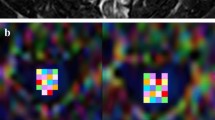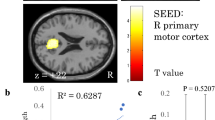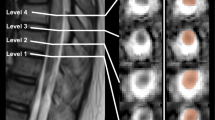Abstract
Study Design:
A retrospective study.
Objectives:
Diffusion tensor imaging (DTI) reflects pathological change in the spinal cord more sensitively than conventional magnetic resonance imaging (MRI). Electrophysiological examination enables quantitative assessment of spinal cord function. Few studies have addressed the correlation between intraoperative spinal cord-evoked potentials (SCEPs) and DTI. The purpose of this study was to examine whether DTI is an objective index for the diagnosis of the segmental level of dysfunction in cervical spondylotic myelopathy (CSM).
Setting:
Yamaguchi University Graduate School of Medicine, Japan.
Methods:
Using 3.0-Tesla MRI, DTI values for the apparent diffusion coefficient (ADC) and fractional anisotropy (FA) were measured at the disc level C2/C3 through C6/C7 in 11 normal subjects and 10 subjects with CSM. Subjects with CSM were divided into two groups based on the extent of compression according to conventional MRI: single level (n=3) and multilevel (n=7). Intraoperative SCEPs were measured in subjects with CSM. For each group, the ADC and FA values were compared with SCEPs with respect to the segmental levels of dysfunction.
Results:
For all three subjects with single-level compression and six of seven with multilevel compression, the maximal ADC value was observed at the segmental level of dysfunction as per the SCEP. Minimum FA values were observed at those sites in two of three patients with single-level compression and in only two of seven with multi-level compression.
Conclusion:
Our results suggest that ADC might serve as a supplementary diagnostic indicator of the segmental levels of dysfunction in CSM.
Similar content being viewed by others
Log in or create a free account to read this content
Gain free access to this article, as well as selected content from this journal and more on nature.com
or
References
Facon D, Ozanne A, Fillard P, Lepeintre JF, Tournoux-Facon C, Ducreux D . MR diffusion tensor imaging and fiber tracking in spinal cord compression. AJNR Am J Neuroradiol 2005; 26: 1587–1594.
Yoo WK, Kim TH, Hai DM, Sundaram S, Yang YM, Park MS et al. Correlation of magnetic resonance diffusion tensor imaging and clinical findings of cervical myelopathy. Spine J 2013; 13: 867–876.
Song T, Chen WJ, Yang B, Zhao HP, Huang JW, Cai MJ et al. Diffusion tensor imaging in the cervical spinal cord. Eur Spine J 2011; 20: 422–428.
Wen CY, Cui JL, Liu HS, Mak KC, Cheung WY, Luk KD et al. Is diffusion anisotropy a biomarker for disease prognosis of cervical spondylotic myelopathy? Radiology 2014; 270: 197–204.
Seichi A, Takeshita K, Kawaguchi H, Matsudaira K, Higashikawa A, Ogata N et al. Neurological level diagnosis of cervical stenotic myelopathy. Spine 2006; 31: 1338–1343.
Kaneko K, Kawai S, Taguchi T, Fuchigami Y, Ito T, Morita H . Correlation between spinal cord compression and abnormal patterns of median nerve somatosensory evoked potentials in compressive cervical myelopathy: comparison of surface and epidurally recorded responses. J Neurol Sci 1998; 158: 193–202.
Kanchiku T, Taguchi T, Kaneko K, Fuchigami Y, Yonemura H, Kawai S . A correlation between magnetic resonance imaging and electrophysiological findings in cervical spondylotic myelopathy. Spine 2001; 26: 269–274.
Kaneko K, Taguchi T, Morita H, Yonemura H, Fujimoto H, Kawai S . Mechanism of prolonged central motor conduction time in compressive cervical myelopathy. Clin Neurophysiol 2001; 112: 1035–1040.
Uda T, Takami T, Tsuyuguchi N, Sakamoto S, Yamagata T, Ikeda H et al. Assessment of cervical spondylotic myelopathy using diffusion tensor magnetic resonance imaging parameter at 3.0 tesla. Spine 2013; 38: 407–414.
Mamata H, Jolesz FA, Maier SE . Apparent diffusion coefficient and fractional anisotropy in spinal cord: age and cervical spondylosis-related changes. J Magn Reson Imaging 2005; 22: 38–43.
Inano S, Takao H, Hayashi N, Abe O, Ohtomo K . Effects of age and gender on white matter integrity. AJNR Am J Neuroradiol 2011; 32: 2103–2109.
Hori M, Fukunaga I, Masutani Y, Nakanishi A, Shimoji K, Kamagata K et al. New diffusion metrics for spondylotic myelopathy at an early clinical stage. Eur Radiol 2012; 22: 1797–1802.
Demir A, Ries M, Moonen CT, Vital JM, Dehais J, Arne P et al. Diffusion-weighted MR imaging with apparent diffusion coefficient and apparent diffusion tensor maps in cervical spondylotic myelopathy. Radiology 2003; 229: 37–43.
Mamata H, Jolesz FA, Maier SE . Characterizaion of central nervous system structures by magnetic resonance diffusion anisotropy. Neurochem Int 2004; 45: 553–560.
Thomalla G, Glauche V, Koch MA, Beaulieu C, Weiller C, Röther J . Diffusion tensor imaging detects early Wallerian degeneration of the pyramidal tract after ischemic stroke. Neuroimage 2004; 22: 1767–1774.
Werring DJ, Toosy AT, Clark CA, Parker GJ, Barker G, Miller D et al. Diffusion tensor imaging can detect and quantify corticospinal tract degeneration after stroke. J Neurol Neurosurg Psychiatry 2000; 69: 269–272.
Aota Y, Niwa T, Uesugi M, Yamashita T, Inoue T, Saito T . The correlation of diffusion-weighted magnetic resonance imaging in cervical compression myelopathy with neurologic and radiologic severity. Spine 2008; 33: 814–820.
Kanchiku T, Imajo Y, Suzuki H, Yoshida Y, Akashi K, Taguchi T . Correlation between spinal cord function assessed by intraoperative SCEPs and morphology of the compressed spinal cord on MRI. J Spinal Disord Tech 2013, e-pub ahead of print 6 November 2013, doi: 10.1097/BSD.0b013e318291cb61.
Urakawa T, Matsuzawa H, Suzuki Y, Endo N, Kwee IL, Nakada T . Analysis of ascending spinal tract degeneration in cervical spondylotic myelopathy using 3D anisotropy contrast single-shot echo planar imaging on a 3.0-T system. J Neurosurg Spine 2011; 15: 648–653.
Fehlings MG, Skaf G . A review of the pathophysiology of cervical spondylotic myelopathy with insights for potential novel mechanisms drawn from traumatic spinal cord injury. Spine 1998; 23: 2730–2737.
Author information
Authors and Affiliations
Corresponding author
Ethics declarations
Competing interests
The authors declare no conflicts of interest.
Rights and permissions
About this article
Cite this article
Suetomi, Y., Kanchiku, T., Nishijima, S. et al. Application of diffusion tensor imaging for the diagnosis of segmental level of dysfunction in cervical spondylotic myelopathy. Spinal Cord 54, 390–395 (2016). https://doi.org/10.1038/sc.2015.192
Received:
Revised:
Accepted:
Published:
Issue date:
DOI: https://doi.org/10.1038/sc.2015.192
This article is cited by
-
Evaluating tissue injury in cervical spondylotic myelopathy with spinal cord MRI: a systematic review
European Spine Journal (2024)
-
Diagnostic efficacy of tract-specific diffusion tensor imaging in cervical spondylotic myelopathy with electrophysiological examination validation
European Spine Journal (2024)



